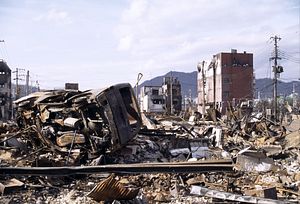A second strong earthquake rattled southern Japan early Saturday morning, around 1:25 am local time. The U.S. Geological Survey (USGS) initially estimated the quake at a 7.0 magnitude (some sources say 7.1), and it came a little more than 24 hours after similarly large earthquakes rattled the same region.
Thursday evening local time, a 6.2 magnitude earthquake struck the southern Japanese island of Kyushu north of Kumamoto, resulting in the deaths of nine people and around 800 injuries. According to the USGS, the quake Thursday was part of a “series of foreshocks in the same region.”
The Associated Press reported “collapsed buildings, streets warped by manholes pushed higher by the earth’s movement, [and] an expressway crunched and buckled” after the first quake. Eight of the nine deaths were in the town of Mashiki, 9 miles outside Kumamoto.
The AP also reported, after the first earthquake, that the Japanese Meteorological Agency (JMA) said it had been “unusually strong for Kyushu.” Kumamoto prefecture is also the site of Japan’s largest active volcano, Mount Aso. An estimated 44,000 people sought refuge in shelters after the initial quake.
A tsunami advisory was issued by JMA after the second quake but was lifted shortly after.
Japan, positioned along what’s known as the Pacific Ring of Fire, is no stranger to earthquakes but activity in Kyushu has kicked up in recent days. According to USGS data there have been eight tremors on Kyushu in the past 24 hours–ranging from 4.5 to this morning’s 7.0 quake. Japan accounts for five of the 11 earthquakes listed by the USGS as “significant” in April so far (before April, Japan last made the list in January).
A government spokesman, Yoshihide Suga, said there were no abnormalities detected at the Sendai nuclear power plant, 74 miles southwest of Kumamoto in neighboring Kagoshima prefecture.
In 2011, Japan was struck by the so-called triple disaster: an earthquake, tsunami, and nuclear meltdown at the Fukushima Dai-ichi nuclear power plant. Five years after the disaster, Japan is still dealing with the repercussions. The 2011 events resulted in the closing of most of Japan’s nuclear power plants and a nationwide reevaluation of the safety of nuclear power, particularly in an earthquake-prone country. The AP reports that Sendai nuclear power plant is the “only one operating in the country.”

































